Unbeknown to football fans at the time, 1980 was the year that saw the start of one of the longest managerial careers in football.
Neil Warnock was appointed as manager of Gainsborough Trinity in the Northern Premier League in 1980.
He has since racked up more than 1000 games in the dugout over a managerial career that has lasted over four decades.
Known for his wit, 75-year-old Warnock previously joked, upon appointment at EFL Championship side Huddersfield Town last season, that he wasn’t ‘extinct yet’.
This, given his reputation of saving clubs from the peril of relegation late on in campaigns.
However, following a shock early dismissal from the Terriers earlier this season, despite having saved them from the drop only months prior, Warnock hasn’t had to wait too long for a return to management.
He was named Aberdeen’s manager this week following the sacking of Barry Robson.
In this tactical analysis, we will look back at Warnock’s career to date and provide an analysis of how he has successfully saved clubs in trouble.
Furthermore, we will look at the Aberdeen tactics and how Warnock may go about improving the Scottish side’s fortunes.
Over 40 years in the dugout
Since 1980, Warnock has had 20 stints as manager with 16 different clubs spanning the Premier League to non-league.
He has eight promotions to his name, which is an English football record.
However, he has been more known in recent seasons for saving teams from the drop.

The map shows the different sides that Warnock has managed, with the circles representing the matches he has overseen at each club.
The larger the circle, the more games he has managed at that club.
Moreover, the colour of the circles identifies the level of success at each club such that those in pink represent promotion-winning sides and those in yellow are sides he has saved from relegation.
The white circles represent when neither promotion nor steering away from safety was achieved.
The map shows that, as well as the eight promotions, which included back-to-back promotions with Notts County, Warnock has successfully guided sides to safety on numerous occasions.
It is noticeable from the above that when saving such teams, he has had much less time to do so, making his achievements even more impressive.
Last season, Warnock was drafted in to save Huddersfield with roughly a third of the season to go and the club in 23rd place, a point from safety.
The West Yorkshire side went on to survive and clear from danger by nine points.
The 75-year-old only led Rotherham for 16 league games but saved the Millers, having lost only four matches in charge.
Considering the South Yorkshire side had lost eight of the 12 matches prior to Warnock’s arrival, this further exemplifies the veteran manager’s achievement.
It is undoubtedly a skill to arrive so late into a season and make an instant impact, but in his last four managerial appointments, Warnock has done just that.
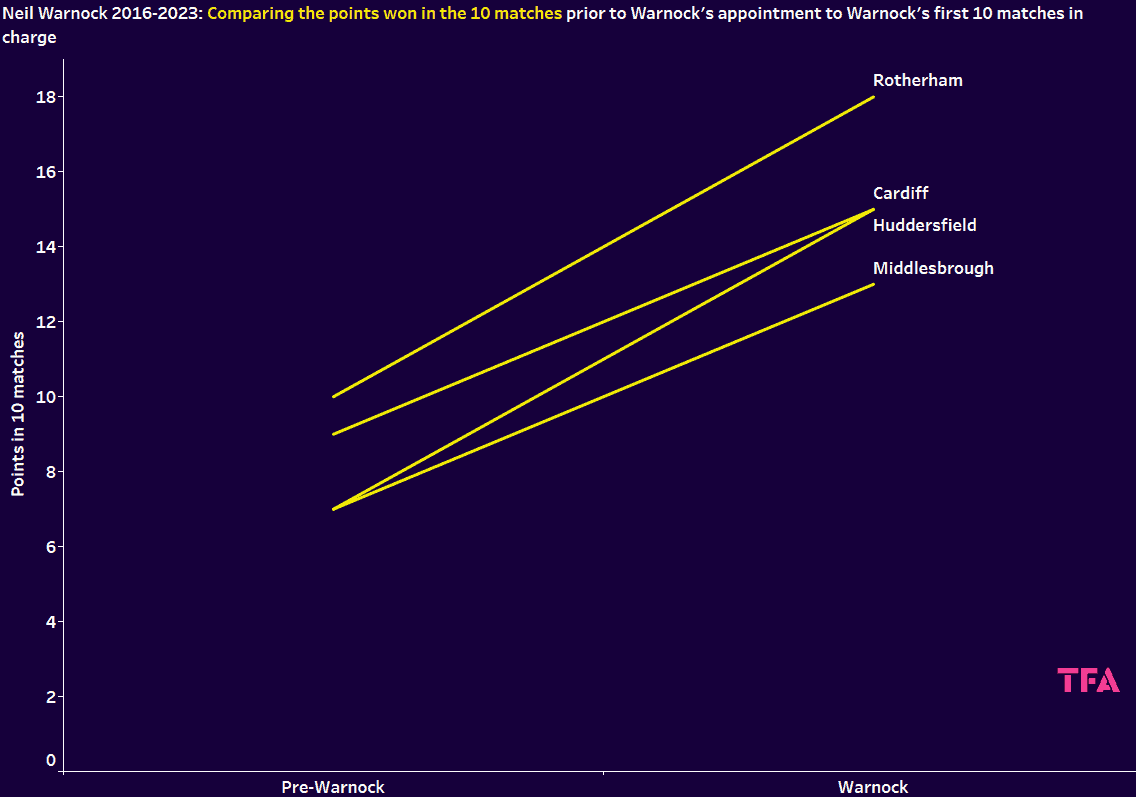
The graph shows the total number of points in the 10 games prior to Warnock’s arrival in his last four positions at Rotherham, Cardiff, Middlesbrough, and Huddersfield.
The graph further shows the total number of points won for each of these clubs in Warnock’s first 10 matches in charge.
In each of the cases presented, there has been an upward trend in fortunes following Warnock’s arrival.
Warnock won 15 points from 30 in his first 10 fixtures in Cardiff, which was more than double the Welsh side had accumulated in the 10 games before Warnock’s arrival.
Just as he had done at QPR, Warnock transformed Cardiff from a side struggling in England’s second tier to promotion winners to the top flight in 2018.
The total cost of Warnock’s promotion-winning Cardiff squad was just £18.6 million.
This value was at the lower end for Championship clubs at the time, so Cardiff gained promotion two points clear from third and 17 points ahead of seventh, demonstrating the level of success.
It hasn’t all been plain sailing for Warnock, but he has endured relegations along the way for different clubs.
That being said, his managerial career has largely been a success.
With a glowing CV, it is not too hard to see why he is still in demand.
He has had a knack for getting the best out of players at his disposal.
A guide to survival
When Warnock has been drafted into clubs mid-season, the remit often is simply to survive.
The 75-year-old manager adopts a simple tactical approach to complement such a simple brief.
Warnock’s sides tend to strip back to football basics with a safety-first approach in clearing the danger rather than playing intricate passes in the defensive third.
It is not perfect every time, but Warnock learns from mistakes.
For instance, when he was appointed Huddersfield manager for a second stint last season despite winning his first game in charge, the Terriers suffered back-to-back 4-0 defeats against Burnley and Coventry.
In the match against Coventry, Huddersfield lined up with three at the back but found themselves gifting openings to Mark Robins’ side in the half-spaces.
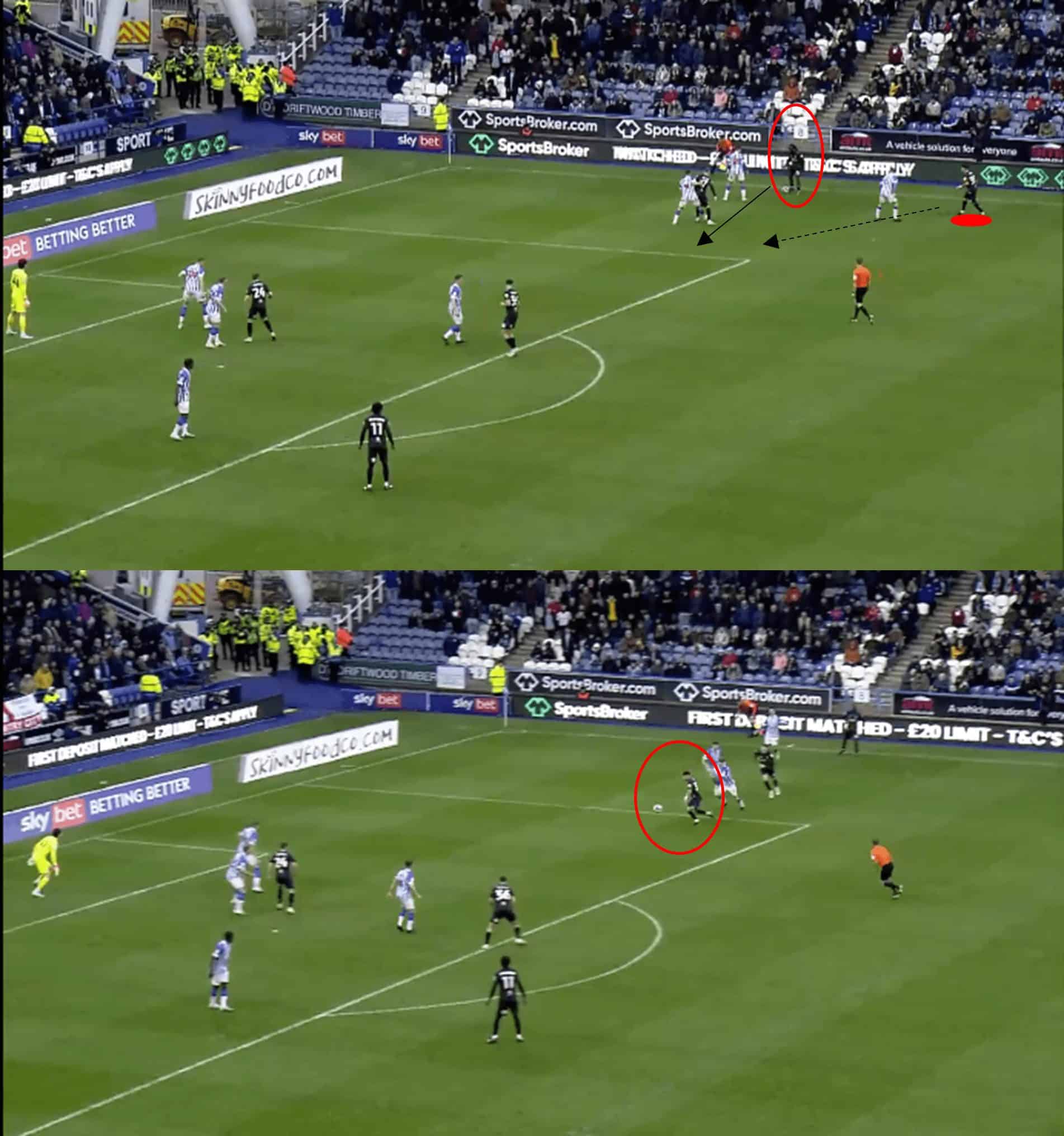
In the above example, Coventry’s Gus Hamer has outmuscled his opponent to break free to receive a pass into the vacant space.
Hamer then goes on to double his side’s lead.
The gap in the Huddersfield defensive line was needless, though, with two Town defenders seen marking one Coventry man near the six-yard box.
A more well-organised defence could have prevented the goal.
It was always going to be difficult matches against eventual champions Burnley and play-off finalists Coventry, and a lack of defensive discipline proved costly against quality opposition.
Warnock learned from this experience, though, and in the next fixture against Bristol City, changed tact to a 4-2-3-1 formation to ensure a tighter defensive unit.
The change in shape proved to be the right approach, and the game ended in a goalless draw.
In this particular match, out of possession, Huddersfield formed a 4-4-2 shape, and as would be proven to be a common trait going forward, a low block was adopted.
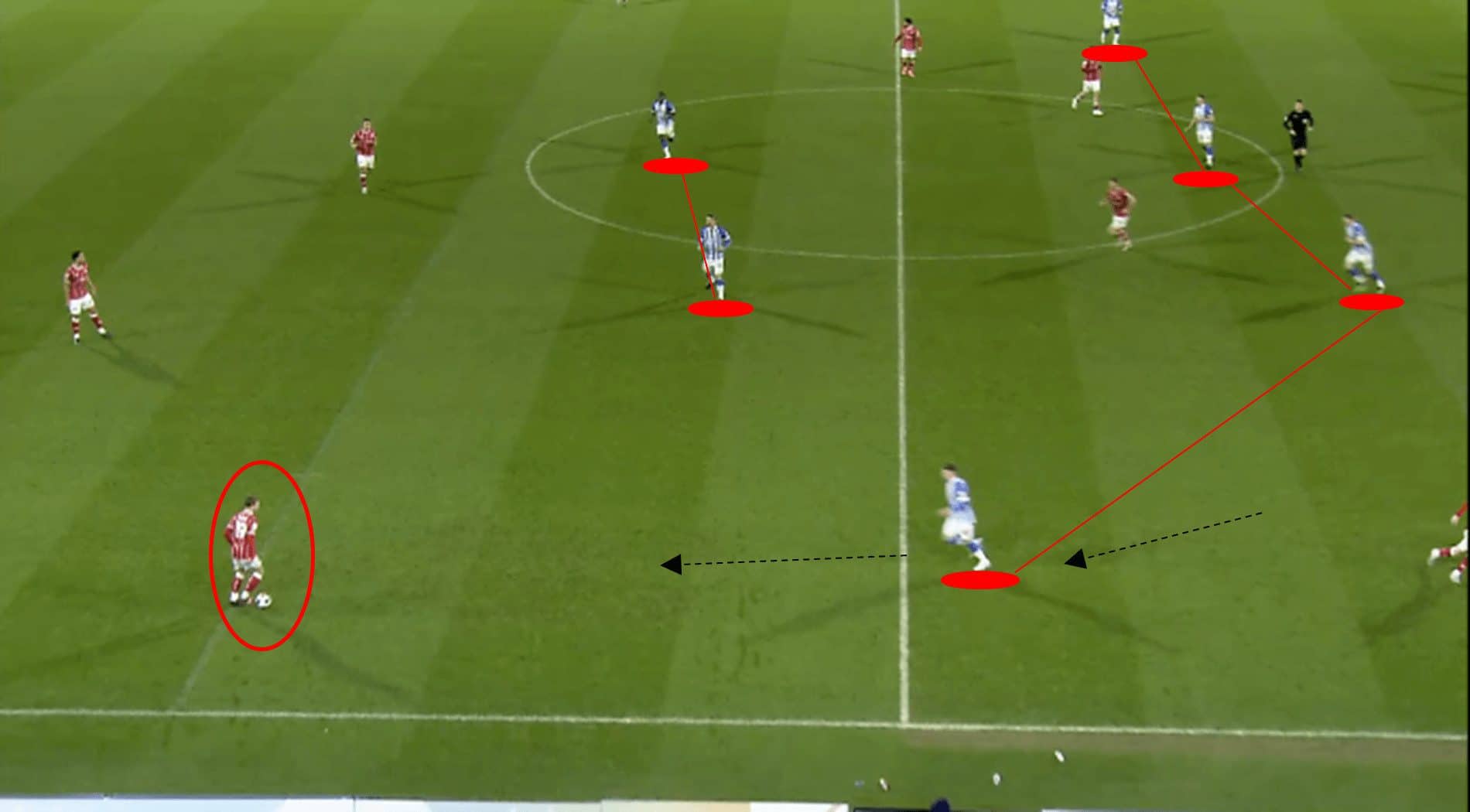
The 4-4-2 formation is shown here, and Huddersfield would be content to drop deeper to put the pressure on the opponent to create an opening.
Warnock’s pressing approach was measured, as seen above, where a Huddersfield player would engage in a press only when the opposition was near with the ball.
It meant that Huddersfield became a strong defensive unit that was organised as they wouldn’t go gung-ho in their off-the-ball tactics and potentially run the risk of players being caught out of possession.
Moreover, Huddersfield would utilise a man-to-man marking approach under Warnock but would communicate well depending on how matches would unfold.
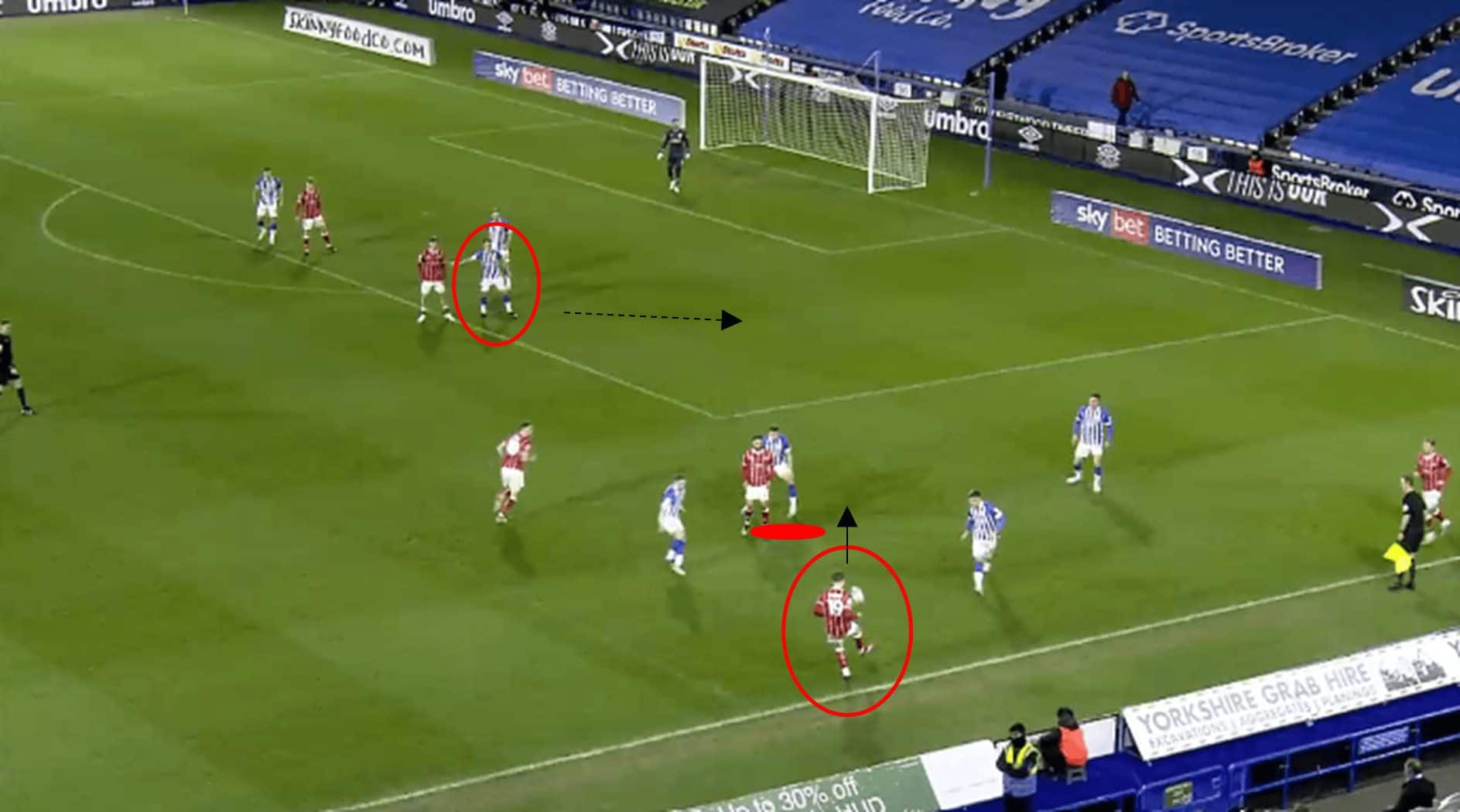
In the match still, the defender on the left of the central defensive partnership has followed his marker, who has gone to receive the ball from the throw-in.
This left a gap in the Huddersfield backline, which Bristol City were ready to exploit.
However, Huddersfield’s defensive midfielder goes to cover the vacant space.
The attempted through ball is blocked, but the movement from the midfielder is much improved from the defensive decision-making shown in the previous example against Coventry.
Whilst Warnock did switch to four at the back, and he would tend to go with a 4-2-3-1 formation in general, he was flexible and would alternate to three at the back on occasions.
The former Sheffield United manager was fully aware that it wasn’t in his remit to build a project at clubs like Huddersfield, and in a safety first policy, it would be a case of how to prevent the opposition at times rather than looking to dictate play.
Utilising three at the back was not uncommon at the John Smith Stadium before Warnock’s arrival.
However, a key difference when playing a 3-4-3 under Warnock is that Warnock would play more defensive-minded players in his midfield rather than wingers.

The heatmap shows the difference in positioning between Sorba Thomas, who featured on the right of midfield in a 3-4-3 under Mark Fotheringham, and Rarmani Edmonds-Green, who would play in a similar role under Warnock.
While Thomas was more likely to occupy more advanced areas of the pitch, Edmonds-Green was more cautious, providing greater defensive stability.
For all the positives that Warnock brought from a defensive point of view last season, he was equally beneficial to getting the best out of the Huddersfield attack.
The Terriers scored 1.27 goals per match last campaign under Warnock compared to just one goal per game last season before his arrival.
Warnock’s attacking playing style is a direct approach, looking to be positive on the ball as soon as his sides regain possession.
This approach was used to good effect at Huddersfield as they would look to hurt teams on the break.
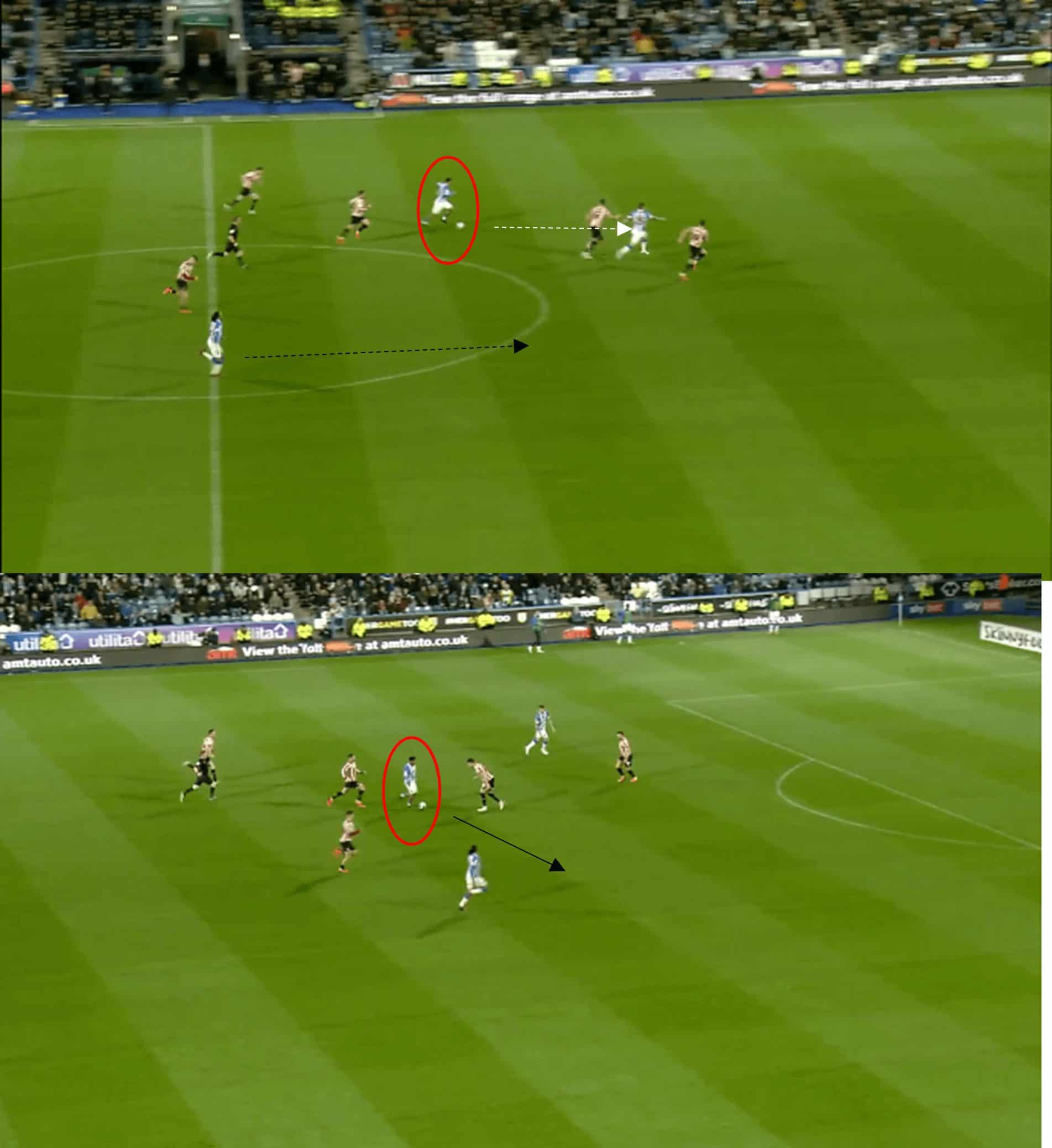
Following pressure from Sheffield United, Huddersfield cleared the danger, launching the ball forward.
Josh Koroma outmuscles his marker, and the more obvious ball is to play in the through ball.
However, Koroma spots the run of the unmarked David Kasumu, who is able to get a shot away.
Kasumu could have easily stayed back but like most players in a Warnock side, decided to advance forward when he saw an opening.
This brings us to the player mentality of Warnock’s teams as Warnock’s personality ensures strong man management skills, whereby players would run through a brick wall for their gaffer.
It is no coincidence that players will often enjoy their more successful playing years with Warnock in charge.

One example in recent seasons was from Warnock’s time at Middlesbrough when he got the best out of young left-back Marc Bola.
The table shows Bola’s generally stronger statistics per 90 from the 2020-21 campaign with Warnock at the helm compared to the following two seasons under different leadership.
Bola may have feasibly been sold before Warnock arrived.
The veteran manager’s ability to work with the players at his disposal will be hugely encouraging for Aberdeen fans.
What could lie ahead for Aberdeen?
Among Scottish Premiership supporters, there is an acceptance that Celtic and Rangers will hold the top two spots by the end of the season.
Therefore, Aberdeen fans expect a third-place finish – a feat they achieved last season.
However, it is a different tale at present as the time of writing, the Dons occupy eighth place, 20 points behind Hearts in third.
Despite the huge points difference with Hearts, Aberdeen have only scored marginally fewer goals than their rivals.
From an attacking perspective, it won’t be anticipated that Aberdeen’s style will change much under Warnock as they already adopt a direct approach.
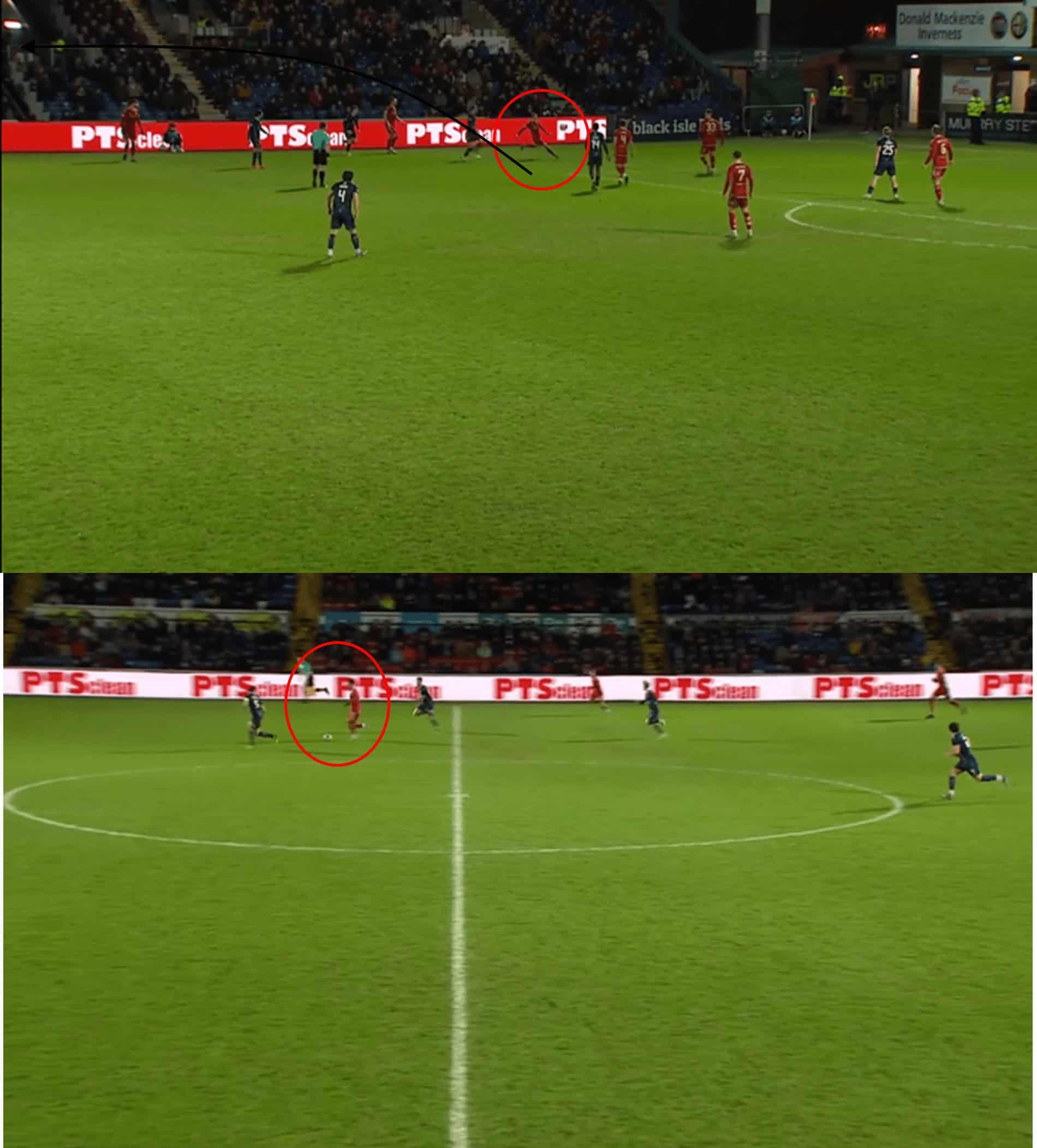
Aberdeen have launched the ball deep within their own half, and Bojan Miovski has controlled well before taking on the last defender and scoring.
A long ball style is synonymous with Aberdeen as they currently rank 4th in the division for direct attacks – 31 in total – as well as direct speed in attack, averaging 2.05m/s.
A positive at Pittodrie is that in Miovski, they have a goal scorer.
The Macedonian has scored 12 goals this season, the second-highest in Scotland’s first tier.
However, on the flip side, Miovski’s goals have accounted for nearly 50% of Aberdeen’s league goals this campaign.
Warnock’s man management skills will be important in getting the midfield firing, too, to lighten the load on his forward.
However, part of the issue at Pittodrie in the attacking phases is that the long balls ensure the play bypasses the midfield at times.
This, in turn, makes it difficult for any creative sparks from the middle of the pitch.
Although Warnock prefers a direct approach, with an organised structure and strong pressing play, Aberdeen’s attacking fortunes may change as more of the midfield will become involved in the build-up play.
The more pressing matter at Pittodrie, however, is the defence.
Aberdeen has one of the worst defences in the division at present, having kept only one clean sheet in their past 10 league games.
Moreover, the Dons have conceded the first goal in 60% of their last 10 league games.
This points to a side struggling to get a hold of matches at present.
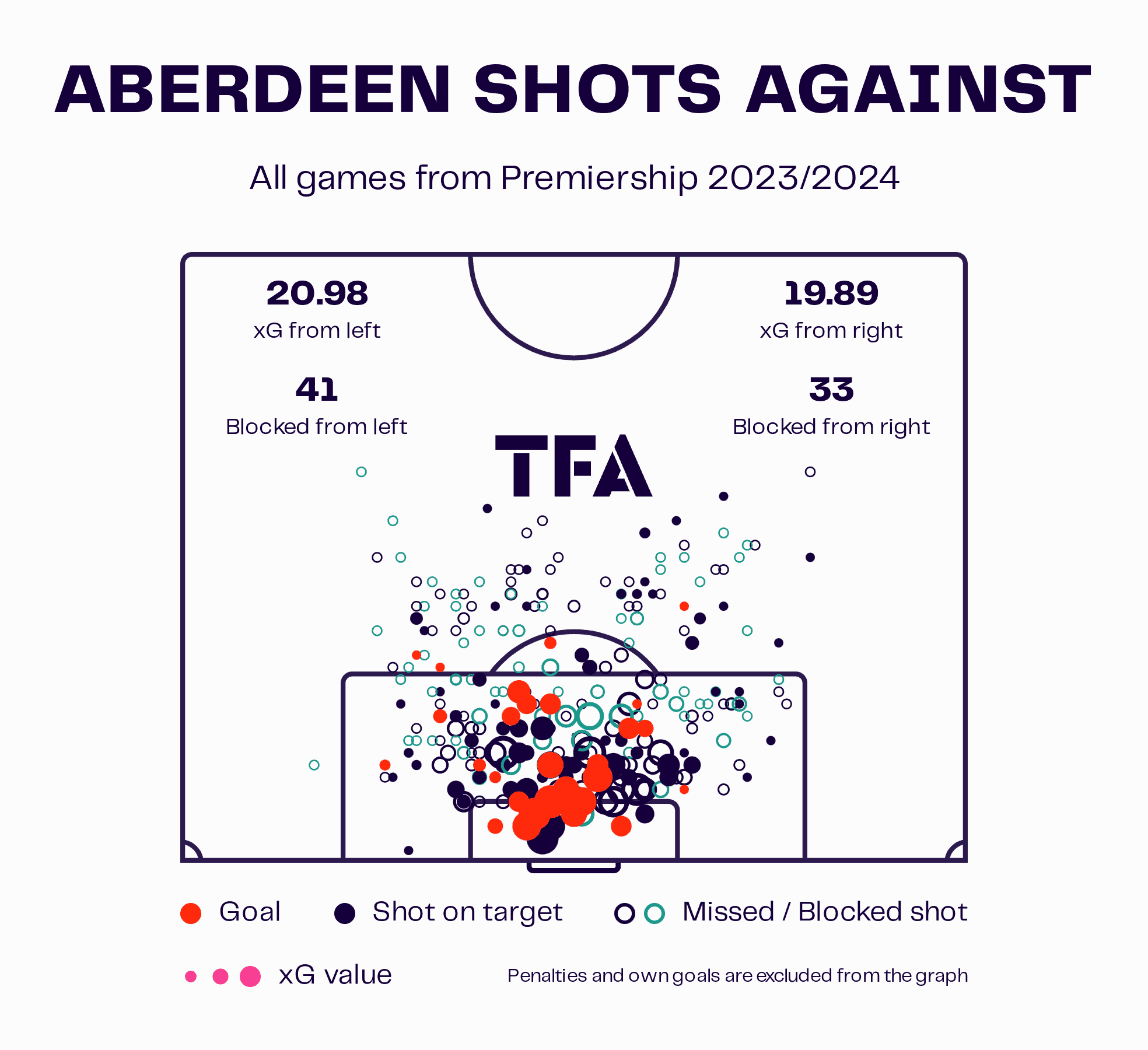
The graphic shows the shots against Aberdeen in the league this season.
It is striking that they aren’t conceding many goals from acute angles or wild punts from outside the area.
It appears that their opposition are able to score opportunities inside the area with quite high goal expectancies.
This indicates sides have been able to pick apart the Aberdeen backline.
Under Robson, Aberdeen’s formation would alternate, but until recently, a back three was more often favoured in a 3-4-1-2 shape.
In playing three at the back, however, Aberdeen struggled in defending the wings.
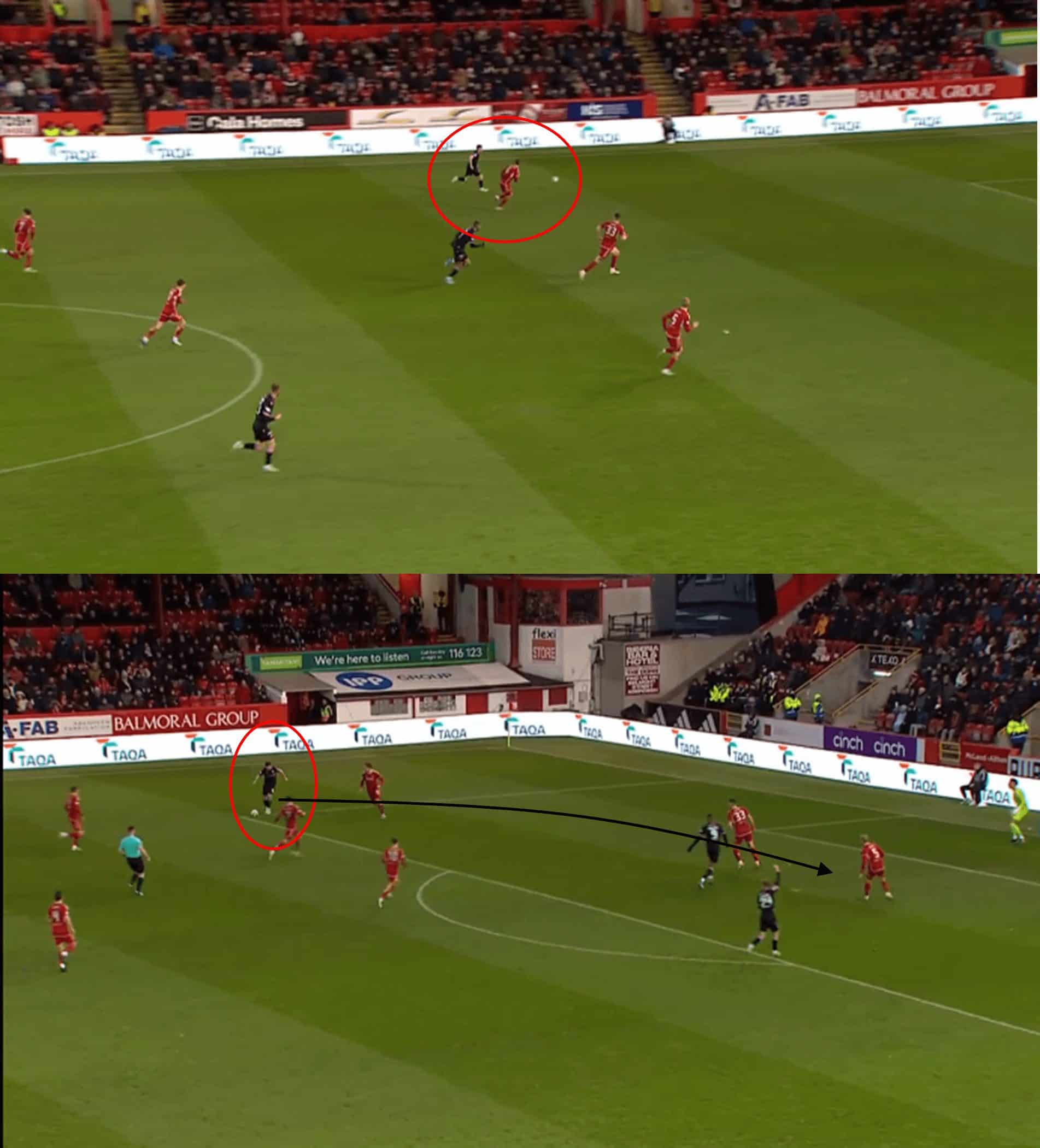
As St Mirren plays out to the left wing, Aberdeen has not covered the run, and all three of the back three are chasing back.
The defenders do not track the run of the opposition, and after an initial scramble in the box following the cross, Mark O’Hara runs into the area unopposed to fire his side into the lead.
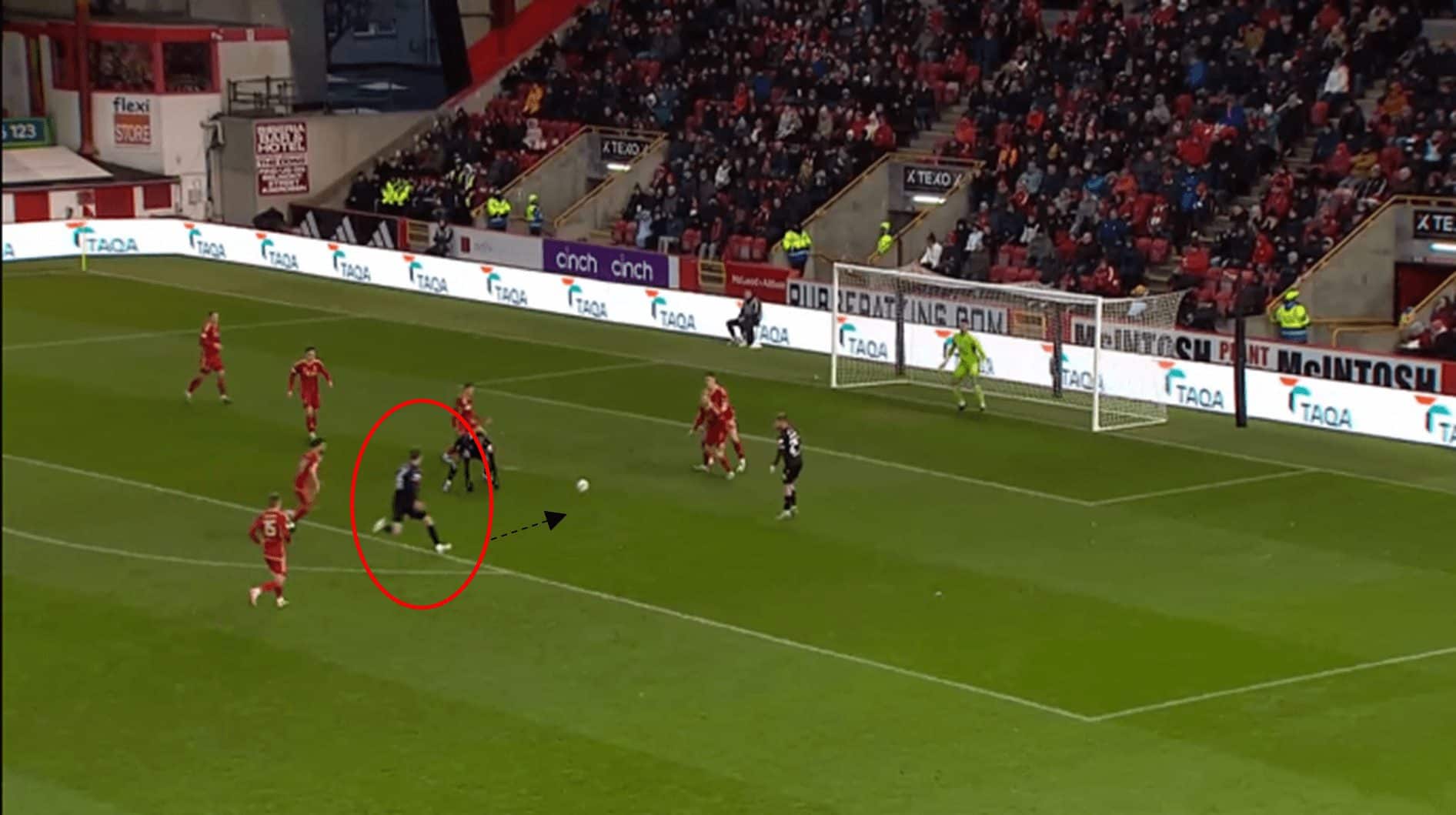
Even when Aberdeen opted for five at the back, they have been punished on the wing.

Aberdeen defends narrow in a back five here.
Celtic are able to exploit the space on the left, passing out to the touchline, to then dribble into space.
Celtic eventually scored following a cross.
Although the tactical shape is evident, there was a lack of organisation in responding to the positioning of the Celtic players.
Too many times this season, Aberdeen have been too open at the back, and it wouldn’t be too surprising if Warnock switches to a back four.
Especially given the Dons’ last clean sheet came with a four-man defence, reverting to a back four with full-backs will give some hope of building some solid foundations.
Any Warnock side is disciplined, and the man-to-man marking seen at Huddersfield will likely be replicated in Scotland to ensure stronger defensive displays from incoming crosses.
Although simple by design, if every player can follow simple instructions to the tee, the only way can surely be up for Aberdeen.
Conclusion
In this tactical analysis, we have highlighted Warnock’s glittering career to date and his exceptional record in more recent seasons of saving sides from the drop.
With quality man management and sound defensive discipline, the 75-year-old has struck a good balance in the past of making his sides hard to beat without compromising on attacking credentials.
The immediate task at Aberdeen will be a defensive reboot as well as instilling confidence into his players.
Whilst the Warnock approach is simple, for Aberdeen fans in the upcoming months, it will be anything but boring.






Comments